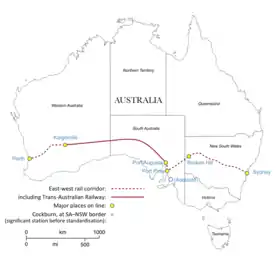Sydney–Perth rail corridor
Australia's east–west rail corridor is a 1,435 mm (4 ft 8 1⁄2 in) standard gauge line that runs for 4,352 kilometres (2,704 mi) across Australia from Sydney, New South Wales, to Perth, Western Australia.[1][2]


The Indian Pacific long-distance passenger train operates along the entire route[3][note 1] and The Ghan along part of it.[4] A number of local passenger services operate at each end.
The corridor is heavily trafficked by freight trains. As of 2008, the rail corridor carried 81 per cent of land freight between the eastern states and Perth, up from 60 per cent in 1996–97;[5] and in November 2007, 3.46 billion gross tonne-kilometres of freight was carried, a record at the time.[6]
As of 2020, major freight operators on the corridor include Pacific National, Aurizon, and SCT Logistics.
Historically, as a consequence of differing choices of gauges by three state governments, passengers and freight on the east–west journey had to be trans-shipped at Broken Hill, Port Pirie, and Kalgoorlie. These stations were on the following lines (from east to west):
- the New South Wales Government's standard-gauge Sydney–Broken Hill line, opened in 1927[7]
- the Silverton Tramway Company's short narrow-gauge line from Broken Hill to Cockburn, opened in 1888[8]
- the South Australian Government's narrow-gauge Cockburn–Port Pirie line, completed in 1888[9]:27
- the Australian federal government's standard-gauge Port Pirie–Port Augusta line, opened in 1938,[9]:27 and its contiguous standard-gauge Trans-Australian Railway, opened in 1917 as a project of Australia's federation[10]
- the Western Australian Government's narrow-gauge Eastern Goldfields Railway from Kalgoorlie to Perth, opened in 1897.[11]
Notes
- The Indian Pacific also makes a diversion to Adelaide, from where The Ghan originates.
References
- "Trans-Australian Railway". National Museum of Australia. 22 April 2020. Retrieved 4 July 2020.
- "Another record East West haul" (PDF). Links. Australian Rail Track Corporation. November 2006. Archived from the original (PDF) on 20 July 2008. Retrieved 6 April 2008.
- "Indian Pacific – Sydney to Perth". Journey Beyond Rail Expeditions. Great Southern Rail Limited. April 2020. Retrieved 15 April 2020.
- "The Ghan". Journey Beyond Rail Expeditions. Great Southern Rail Limited. April 2020. Retrieved 15 April 2020.
- "ARTC – News – NSW Lease 2004 Summary". artc.com.au. Archived from the original on 23 March 2008. Retrieved 6 April 2008.
- "ARTC – East West Rail Freight Record Tumbles". artc.com.au. Archived from the original on 24 October 2009. Retrieved 6 April 2008.
- "Broken Hill line". NSWrail.net. 2020. Retrieved 4 July 2020.
- Hon. J.B.M. Fuller, Minister for Decentralisation and Development (22 February 1972). "Silverton Tramway Land Vesting Bill". Parliamentary Debates (Hansard). New South Wales: Legislative Council. p. 4347.
- "South Australia's mixed gauge muddle" (PDF). National Railway Museum [South Australia]. National Railway Museum. 2013. Archived from the original (PDF) on 28 February 2016. Retrieved 4 July 2020.
- "The last link". The West Australian. XXXIII (4850). (Original, Perth. Digital reproduction, Canberra: National Library of Australia – Trove digital newspaper archive). 18 October 1917. p. 4. Retrieved 4 July 2020.
- Newland, Andrew; Quinlan, Howard (2000). Australian Railway Routes 1854–2000. Redfern: Australian Railway Historical Society. pp. 63, 67. ISBN 9780909650490.
Bibliography
- Avery, Rod (2006). Freight Across the Nation: The Australian Superfreighter Experience. Brisbane: Copyright Publishing Co. ISBN 1876344474.